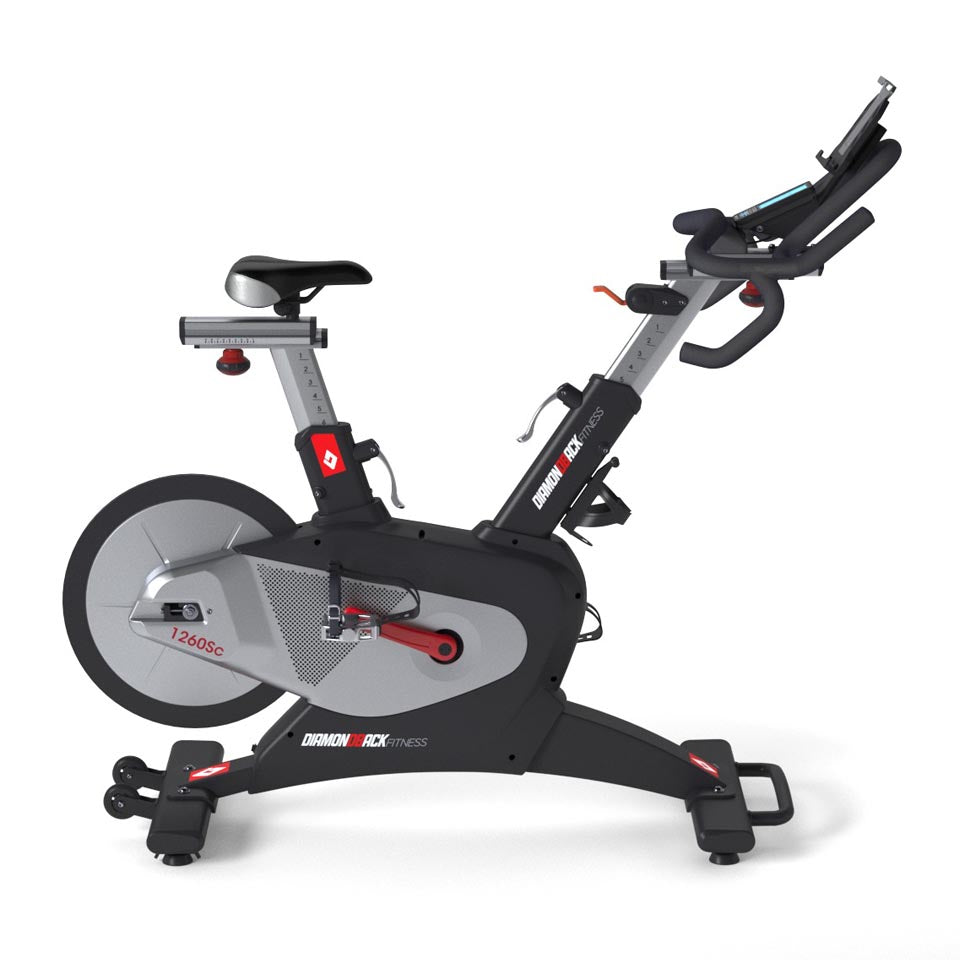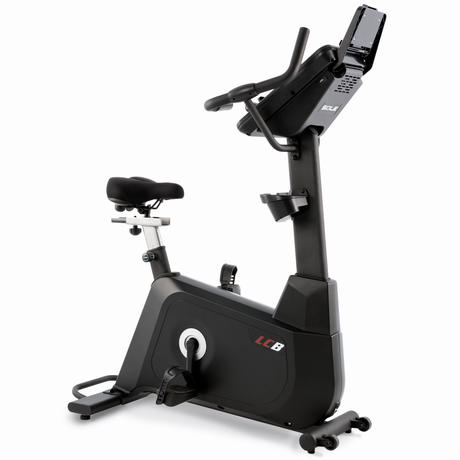When people head to the gym, they will notice that there are usually two of four commonly used exercise bikes available for use.
The spin bike and the upright stationary bike (the others being a recumbent bike and an air/fan bike).
Each bike provides users with its own unique fitness advantages.
Still, it is important to know the differences between the spin bike vs stationary bike before hopping on your indoor biking adventure.
Spin Bike vs Stationary Bike – How Does Each Work?
Spin Bike
DiamondBack Fitness 1260sc Rear Wheel Studio Cycle
- Heavy 31 lb flywheel
- Computer controlled magnetic resistance
- Lever selected resistance changes
- Distance, watts, heart rate, cadence, and elapsed time.
- Built in water bottle and tablet holders
- No monthly subscriptions
- 5 year frame warranty, 3 year warranty on parts & electrical components
A spin bike is a specialized piece of cardio equipment that when used properly can help you build muscle, lose weight and increase your cardiovascular endurance.
Constructed of extra strength steel to hold a person’s weight while being used at an intense rate of speed, a spin bike’s specially designed wheel is attached to a weighted flywheel which has pedals attached to it.
Riders can alter the tension of the wheel by adjusting a knob located either on the handlebar or in front of the seat along the frame.
Spin bike pedals often come equipped with straps to help keep the rider’s feet secure while pedaling at high speeds.
Spin bike riders usually take classes or on-screen programs that imitate an outdoor ride through various terrain and speeds.
They usually alternate between sitting or standing and adjusting the tension on the flywheel.
Stationary Bike
Sole LCB Upright Stationary Bike
- 40 levels of resistance
- 6 workout programs
- 10.1 ” LCD display
- 2 heart rate monitors (including chest strap)
- Cooling fans
- Bluetooth connectivity, Speakers, USB Charging Port
- Water bottle and tablet/phone holder
- Lifetime warranty on frame, 5 years on parts & electrical
A stationary bike is one of the oldest and most effective pieces of cardio equipment on the market that helps riders burn calories while increasing lower-body muscle strength.
One of the biggest pros of the stationary bike is that it provides a low-impact aerobic workout.
There are three types of stationary bikes on the market, each of which provides riders with their own unique benefits.
The most popular version of the stationary bike is the upright bike.
Designed with the intent of seated cycling, the upright stationary bike is best suited for those who are looking for a low to mid-intensity workout or as a warmup/cool-down option.
Often equipped with a console of pre-loaded programs, you can adjust the stationary bike’s resistance either through the various programs or by the speed at which you choose to pedal.
As with the spin bike, stationary bikes are used to help increase muscle strength and improve cardiovascular fitness levels.
Many stationary bikes will come equipped with programs that monitor your distance, speed, heart rate, calories burned, resistance and incline levels, time, and revolutions per minute.
Spin Bike vs Stationary Bike – 4 Differences

While the end result of an exercise bike is to ultimately improve your level of fitness, there are several differences when comparing a spin bike vs stationary bikes.
Whether you use the bikes at your local gym or are looking to purchase one for your home workout program, it is important to take the following factors into consideration.
1. Flywheel
The exposed flywheel of the spin bike is significantly heavier than that of a stationary bike.
The heavier flywheel of the spin bike, which has its pedals attached means that when you physically stop pedaling the flywheel continues to move, as do the pedals.
In order for the bike to come to a complete stop, the momentum of the flywheel must come to a dead stop.
The heavier flywheel also means you will need to use more power, which could be more favorable for those wanting a more intense workout.
The lighter flywheel of the stationary bike, which usually weighs a couple of pounds helps to maintain the relative smoothness of the ride and when you cease pedaling, as with a regular street bike, the flywheel will continue to rotate.
2. Seat & Position
Like outdoor bikes, the design of a spin bike vs stationary bike differs.
Spin bikes mimic that of road bikes with posture and body position.
The handle position allows the rider to lean forward much more than they would on a stationary bike.
The bike seat for a spin bike will also provide a wider range of seat height options than an upright bike, which occasionally looks like a cramped road bike because of the short distance between the seat and handlebars.
Most spin bikes have handlebars positioned slightly lower than the seat, making riders feel like they are a part of the Tour De France race.
One major difference between the body position on the spin bike versus the stationary bike is the ability to stand and pedal.
While you can do it on a stationary cycle, it is rather awkward because of the console and the setup of the bike.
Also, most upright bikes tend to have more padded and wider seats than spin bikes as riders sit on them for longer periods of time.
3. Price
As with most pieces of exercise equipment, exercise bikes come in a variety of prices for both the spin and stationary versions.
When you take into consideration the quality of materials and construction, the various console programs and technology (for stationary version), the types of resistance, and any other bells and whistles, all come into play when considering the price.
In general, a spin bike will cost more than a regular stationary bike as they are often more durable and built with better quality materials.
Both bikes have a low market price of approximately $300 brand new, while higher quality versions of each can easily reach four digits in price.
For those who purchase a stationary bike with an on-screen workout program, please keep in mind the additional charges that will come with the software or program membership, which can be approximately $50+ a month.
4. Workout Intensity
As mentioned, the level of intensity differs when comparing a spin bike vs stationary bike.
More often than not, when used properly you will burn more calories on a spin bike.
That is because you are incorporating multiple muscle groups (when you stand up) and pedaling at a faster pace.
Spin Bike vs Stationary Bike – Which is Better?

As with comparing many things in life, there are always pros and cons that come with deciding which option is better suited for you.
As we have already covered the financial and material aspects, it is just as important to look at which option is better suited for your physical fitness goals.
Your Current Fitness Level
Knowing what you want to get from owning an exercise bike is important when determining whether to buy a spin or upright stationary bike.
Simply put, spin bikes are suited for individuals who are looking for workouts that incorporate interval training with different intensities and being able to alter positions.
While stationary bikes are more suited for individuals looking to remain seated for an endurance ride.
What Are Your Goals?
Outdoor Like Bike
It is impossible to mimic riding an outdoor bike indoors, because of factors such as weather, road conditions, elevation levels, balance & stability, and traffic.
However, the bike that gives you the closest comparison would be a spin bike.
Although biking indoors has its perks, it’s hard to argue against getting outdoors for some fresh air and vitamin D.
More Intense Workout
When used properly the spin bike will provide users with a more intense and challenging workout than a stationary bike.
Requiring more muscle activation, which includes the upper body and core, the spin bike is more often used for HIIT workouts with the goal of enhancing cardiovascular fitness with the average one-hour workout session burning nearly 600 calories.
Increase Cardiovascular & Endurance
Providing riders with a low-impact, calorie-burning workout, the upright stationary bike is a better option for building cardiovascular endurance than the spin bike, primarily because of the comfort of the design.
While you might not burn as many calories in a short period as on the spin bike, the upright stationary bike does not put as much stress on your joints.
This lack of joint stress could allow you a longer, more comfortable ride.
Custom Workouts & Track Calories
Unless you are using a cycling program app for your spin bike, riders are better off using an upright stationary bike and its built-in console for their customized workouts and calorie tracking.
Most consoles will also calculate distance, speed, heart rate, time and cadence.
While entry level bikes have the basic LCD display, they often equip higher end models with a video screen that allows riders to watch tv.



